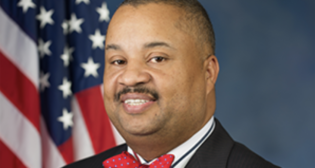
Grade Crossing Improvements Discussed at Rail Subcommittee Hearing
Written by Carolina Worrell, Senior Editor
From Left to Right: Federal Railroad Administrator Amit Bose, NTSB Chair Jennifer Homendy, AAR President and CEO Ian Jefferies, and INDOT Commissioner Michael Smith.
Four witnesses on Jan. 18 discussed improving safety at highway-rail grade crossings at a hearing of the Subcommittee on Railroads, Pipelines, and Hazardous Materials.
The hearing, entitled, “Oversight and Examination of Railroad Grade Crossing Elimination and Safety,” included remarks from Federal Railroad Administration Administrator Amit Bose, National Transportation Safety Board (NTSB) Chair Jennifer Homendy, Association of American Railroads (AAR) President and CEO Ian Jefferies, and Indiana Department of Transportation (INDOT) Commissioner Michael Smith, who examined highway-railroad grade crossing eliminations and safety improvements.
“There are approximately 212,000 highway-rail grade crossings in the U.S. In 2022, there were [more than] 2,000 accidents at grade crossings,” stated Subcommittee Chairman Troy Nehls (R-TX) in his opening remarks.
“Grade crossing accidents and fatalities are entirely preventable. States make the determinations when it comes to addressing grade crossings, including weighing safety, railroad, and vehicle traffic considerations. Eliminating a rail crossing, where necessary and possible, eliminates the potential for a grade crossing incident.
“The Infrastructure Investment and Jobs Act (IIJA) created a new grant program known as the Railroad Crossing Elimination (RCE) Grant Program meant to help states and communities with grade crossing elimination and safety.
“The program received a total of $3 billion over five years, or roughly $600 million per year. In Fiscal Year 2022, the Federal Railroad Administration (FRA) awarded $570 million in RCE grants to projects in 32 states that addressed over 400 at-grade crossings. My home state of Texas received roughly $86 million for five major grade crossing projects.
“It is expected that FRA will announce a notice of funding opportunity (NOFO) soon seeking applications for more grade crossing improvement projects.
“We must ensure this process is transparent, easy to navigate, and that the money is accessible for all communities. It is my hope that the FRA will work with Congress to achieve these goals while properly overseeing this new grant program.
“Further, with the next surface transportation reauthorization fast approaching, it is time to begin examining these programs to understand what’s working, the right levels of funding, and how to build on existing grade crossing elimination and safety efforts such as the RCE Grant Program,” concluded Nehls, who added that he was interested in learning about how “existing programs can be improved, the resources that states and communities need, and how government red tape can be reduced to make these funds more accessible and the process less complicated.”
Following are excerpts from the four witnesses’ testimonies.
Amit Bose, Administrator, FRA
“Safety professionals cover every discipline of railroad operations and represent a majority of FRA’s workforce. For example, across the U.S., FRA grade crossing safety inspectors inspect grade crossings; perform critical outreach work to educate the public; and work with railroads, state departments of transportation, and communities to ensure compliance with FRA safety regulations. As part of its commitment to safety, FRA has nearly doubled its Grade Crossing and Trespasser Outreach Division to 48 staff in the past two years.”
“FRA ensures that railroads comply with safety regulations, enforce their own operating rules, and take seriously their responsibility to local communities. In addition, FRA partners with the Federal Highway Administration (FHWA), Federal Transit Administration (FTA), Federal Motor Carrier Safety Administration (FMCSA), National Highway Traffic Safety Administration (NHTSA), and others to ensure the safety of people and goods at our Nation’s highway-rail grade crossings,” Bose continued.
Bose went on to discuss how “Congress demonstrated its commitment to grade crossing safety and bolstering our nation’s rail network” when it passed the Bipartisan Infrastructure Law (BIL), creating several new rail investment programs and reauthorizing others.
“In particular, the RCE Grant Program provides funding to enhance the health and safety of communities, eliminate highway-rail and pathway-rail grade crossings that are frequently blocked by trains, reduce the impacts that freight movement and railroad operations may have on communities, and improve the mobility of people and goods. Additionally, highway-rail crossing improvement projects are eligible for funding under the Consolidated Rail Infrastructure and Safety Improvements (CRISI) Grant Program,” said Bose.
“In June 2023, FRA announced the first selections under the RCE Grant Program with 63 projects in 32 States receiving more than $570 million. These awards address more than 400 at-grade crossings nationwide, improve safety, eliminate grade crossings through grade separations and closures, improve existing at-grade crossings, and enhance mobility of people and goods, benefiting railroads and communities,” added Bose.
Jennifer Homendy, Chair, NTSB
“In 2022, 272 people were killed in collisions at grade crossings, and the rate of grade crossing collisions has increased significantly over the past decade, from 2.811 per million train miles in 2013 to 3.758 per million train miles in 2022. This represents the overwhelming majority of rail fatalities in the United States, and we are grateful that Congress included several provisions in the Infrastructure Investment and Jobs Act of 2021 (IIJA) to address grade-crossing and trespasser safety. In the last 10 years, the rate of grade crossing incidents has increased by one incident per million train miles,” said Homendy.
“The NTSB has a long history of investigating these kinds of preventable collisions at grade crossings. Over the years, our agency has issued many recommendations aimed at improving the safety of motorists and train occupants at crossings,” added Homendy, who went on to cite the numerous recurring safety issues identified by NTSB’s investigations.
These include:
- “Grade separation is needed at high-risk locations.
- “Improved signage and warnings for motorists are needed at many crossings.
- “High vertical profile crossings (“humped crossings”) continue to cause problems nationwide, with trucks and buses becoming stuck on tracks.
- “Traffic queues at grade crossings must be avoided, and they require active traffic management by local highway authorities to ensure vehicles are not trapped on tracks.
- “Adequate line of sight at both public and private grade crossings is needed to prevent collisions.
- “Advanced technology solutions (i.e. improved vehicle navigation systems, connected vehicle-to-train, GPS tracking) could be used to warn train operators and motorists of active railroad tracks in the area or of impending conflict.
- “Improved data and reporting requirements for both public and private highway–railroad grade crossings are needed.
- “Increasing participation in Operation Lifesaver to educate road users about safely walking, rolling, or driving near grade crossings.”
Ian Jefferies, President and CEO, AAR
“Most grade crossing and rail-related pedestrian accidents are preventable and can best be reduced through education, engineering, and enforcement. The average American does not realize the destructive force of a fast-moving, fully loaded freight train. Operation Lifesaver (OLI), a non-profit whose central message is “look, listen, and live,” deserves special commendation for its efforts to educate the public about the dangers of grade crossings and trespassing on railroad property. Operation Lifesaver started in Idaho in 1972 and today has chapters in nearly every state. Its educators, many of whom are current or retired rail industry employees, have provided free safety presentations to millions of Americans, including school children, driver’s education students, truck drivers, and bus drivers,” said Jefferies.
Railroads, Jefferies added, also spend hundreds of millions of dollars each year to improve grade crossing safety through:
- “Cooperating with state agencies to install and upgrade warning devices and signals and maintain them in perpetuity.
- “Coordinating with state and local governments to plan and fund grade crossing separation projects.
- “Supporting Operation Lifesaver with financial and other resources.
- “Providing resources to close unneeded crossings.
- “Coordinating with law enforcement and others to address safety concerns.
- “Installing signs at grade crossings with telephone numbers the public can use to alert railroads to unsafe conditions.
- “Supporting tough penalties for grade crossing traffic violations and the inclusion of grade crossing safety in drivers’ education programs.
“Freight railroads recognize the importance of continuing their commitment to the safety of their employees, their customers, and the communities in which they operate. The rail industry will continue to work closely and cooperatively with Congress, individual states, the FRA, and others to reduce the frequency of accidents at highway-rail crossings and across the network. Railroads must keep improving in all aspects of rail safety, but the progress made demonstrates that the industry will do what it takes to meet that challenge,” Jefferies concluded.
Michael Smith, Commissioner, INDOT
“In Indiana, multiple agents of change are in play related to rail crossing safety, one of those being INDOT’s Local Trax Rail Overpass Program, through which the agency serves as an example to others in developing innovative programs that promote and encourage collaboration and teamwork amongst state, local, and private partners,” said Smith.
“In 2018, twelve local communities were awarded Local Trax funding for grade separation, crossing closure and other safety enhancement projects at local rail intersections, totaling more than $125 million in state dollars. We anticipate eleven projects across the state to be under construction by the end of next year (2025),” added Smith.
Smith went on to cite the multiple projects in Indiana that were recipients of a total of $21 million in RCE grants from the FRA, including the Governor’s Parkway Railroad Overpass project in Hammond, Ind.
The nearly $17 million project, Smith says, will eliminate two at-grade crossings and provide a “safer, more efficient grade-separated overpass for all road users in an area that regularly sees long-term train blockages, resulting in access concerns for pedestrians, drivers and emergency services.”
“These efforts, through INDOT’s Local Trax program, are an illustration of the agency’s ongoing commitment to engage and collaborate with local partners to improve safety, mobility and quality of life for Hoosiers,” said Smith.
“The State has also seen exponential growth in successful use of Section 130 Rail-Highway Crossing Program funds. Through the federal program, Indiana is on track to improve 85 of the state’s top 100 high-risk public crossings over the next five years (by 2029),” added Smith.
“Indiana’s efforts are outlined in the state’s Highway-Rail Grade Crossing Safety Action Plan. As we await final plan approval from the FRA, a variety of strategies have been identified to continue our focus on system-wide, multidisciplinary solutions that will be prioritized for funding and implemented going forward, including:
- “Closing crossings or creating separations to eliminate interactions between trains and road users.
- “Upgrading passive warnings to active, improving and maintaining existing devices.
- “Engaging local agencies on traffic signal preemption and how it can be implemented.
- “Collaborating with railroads and local agencies to explore broader implementation and maintenance of passive warning enhancements.
- “Informing and educating stakeholders on highway-rail grade crossing topics.
- “Considering rail-grade crossing safety in all transportation projects.
- Collaborating with enforcement agencies to help prevent crashes at highway-rail grade crossings.”
The testimonies of the four witnesses are available to download in full below:



